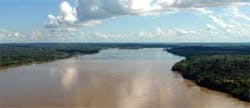Madeira River in Rondonia state, Amazon region
Local consortium beats Europeans to win auction for first of two dams to harness power of the Madeira River in rainforest near Bolivia that are crucial to regional energy demands.
By Peter Howard Wertheim and Dayse Abrantes
On Dec. 10, a consortium of Brazilian companies won an auction to build and operate the 3,150 megawatt (MW) Santo Antonio dam on the Madeira River in the Amazon rainforest near Bolivia. Consorcio Madeira Energetica, led by large construction company Construtora Norberto Odebrecht SA, beat out two other consortiums formed by Spain’s Endesa SA and Franco–Belgian utility Suez. The winning group includes participation of state–owned electricity company Furnas Centrais Elétricas SA, engineering company Andrade Gutierrez Participações SA, Cemig Geração e Transmissão SA power utility and a financial fund made up of Santander and Banif banks, called Fundo de Investimentos e Participações da Amazônia.
Cheaper power
The consortium won the auction by committing itself to sell electrical power from the dam for $43.82 per MW/hour, which is a tariff 35% lower than the highest price set by the government in the bid notice. Although the Brazilian government expects the Santo Antonio dam will cost $5.3 billion, the consortium expects to invest US$7.1 billion.
In May 2008, the government is expected to open bidding on the Jirau dam also a 30–year concession on the Madeira River, which is expected to generate 3,326 MW. The Jirau dam will be constructed 80 km away from Porto Velho and 85 km away from the border with Bolivia.
Together, the two dams are expected to supply 8% of the country’s energy needs. These projects are Brazil’s first large hydroelectric expansion since the Xingo dam on the São Francisco River, completed in 1994. The Santo Antonio dam is expected to come on–stream in 2012 and the Jirau dam in 2013.
The estimated US$15.6 billion Madeira River project, including two hydroelectric dams, navigation locks and captive electrical connection transmission lines connecting the dams, is the largest project in the Amazon region’s history and raises several debates.
Divided opinion
Environmentalists say the dam could harm a pristine part of the Amazon, but the government says it’s needed to help prevent electricity shortages in Latin America’s largest country. Brazil suffered extensive outages that required power rationing in 2001 and President Luiz Inacio Lula da Silva is determined to avoid this from happening again.
According to the Brazilian federal energy regulatory agency (Aneel), currently, the country’s power generation capacity totals 100,166,678 kW of which 76,310,179 kW is hydroelectric generation. Because over 75% of Brazil’s electric energy is supplied by hydroelectric dams, specialists discuss whether Brazil will have enough alternative generation capacity to support prolonged periods of droughts.
After delaying the date five times, the late auction for a 30–year concession for the Santo Antonio dam makes some specialists think the initial plan to start operations by the end of 2012 may be very difficult to attain. Nelson Hubher, the acting minister for mines and energy, acknowledged that work in Santo Antonio dam site would only start in the second half of 2008.
These dams are seen as the cornerstone of the Brazil–Bolivia–Peru energy hub of the Initiative for the Regional Integration of South American Infrastructure (IIRSA), a blueprint for large–scale infrastructure supported by the Inter–American Development Bank (IDB), the Andean Development Corporation (CAF), the Rio Plata Development Fund (Fonplata) and Brazil’s National Economic and Social Development Bank (BNDES).
Aneel estimates that US$8 billion will be invested to build the Jirau dam (3,300 MW) and both dams will require captive transmission lines for US$5 million. The Santo Antonio dam will be near the city of Porto Velho, capital of Rondonia state. The cost estimate doesn’t include the 88 bulb–type turbines or approximately 2,500 km of transmission lines required to connect both projects with the national grid.
“The country will benefit because the power generated will supply the southeast of Brazil, the largest consumer region of the country. We envisage the creation of 20,000 jobs,” said João Canellas, a director of Amel Ltd., a subsidiary of Camargo Correa – a Brazilian construction and infrastructure group. “If construction work begins by September 2008, the best hypothesis is that the Santo Antonio dam will become fully functional by February 2016.”
Environmental concerns
Environmental organizations have mounted a strong campaign against the building of the dams. The Madeira river basin covers about a quarter of the Brazilian Amazon region. Ibama, Brazil’s national environmental agency, took two years to give the go ahead for the project and, last July, attached 33 conditions to allow final implementation.
A report by Friends of the Earth Brazil and the International Rivers Network (IRN) warns that, due to prolonged gold mining in the region, the riverbed of the Madeira upstream from the planned dams is highly polluted with mercury, and any disruption of this metal could cause it to infiltrate groundwater that supplies part of the capital, Porto Velho.
“Scientific studies demonstrate the characteristics of the reservoirs promote bacterial activity, which in environments featuring low light and oxygen, permit mercury to bio–methylate, enabling it to enter the food chain. This fact is of special concern when considering potential for bioaccumulation of mercury in the region’s food chain, given the diversity of carnivorous fish species, which are the staple of riverbank dwelling and urban populations,” argues the report.
Although investors claim the dams will employ “run–of–river” type technology to minimize flooding and estimate only 529 sq. km will be flooded, environmentalists disagree, claiming the project will affect a total area of almost 1 million sq. km, including parts of Brazil, Bolivia and Peru. They also point to the direct conversion of some 80,000 sq. km of forests into associated agriculture development.
Some specialists point to the run–of–river solution as a setback because, during the last two decades, the hydroelectric power capacity doubled in Brazil, while the capacity to save water to face the droughts remained the same. Glenn Switkes, the South American specialist of IRN, said the run–of–river type of dam means that it will primarily depend on the force of the stream flow, rather than on the “hydraulic head” or drop of the water, which is traditionally attained via a large accumulation reservoir.
Still, Switkes added, “this distinction does not guarantee a ‘green’ dam. The river is still dammed, the speed of the water flow through the turbines is not equivalent to that before the dam was built and the ‘pulse’ of high and low water periods, essential for downstream agriculture, fish reproduction, etc. is destroyed”. He also warned that substantial areas can still be flooded by run–of–river type dams, as happened in the case of Yacyretá dam, at the Paraná River, in the Argentina and Paraguay border region, where 80,000 people will be displaced by what is considered a run–of–river dam. The government estimates 4,000 people will be displaced in the Madeira River project and 100,000 migrants will move into the area, seeking work.
“Another factor to consider”, said Switkes, “is that the present engineering design calls for use of 44 bulb turbines in each of the two dams. This huge configuration of turbines has never been used in any dam, worldwide. Companies that plan to bid in the auction, including Suez and Camargo Correa, have indicated their preference for Kaplan turbines, which are also used for ‘low–head’ situations, but could have distinct environmental considerations, including potentially a larger flooded area”.
A river under threat
For Switkes, the Madeira River is under threat. Among large–scale infrastructure projects associated with two hydroelectric dams, there are locks for a 4,200 km waterway for barge passage, permitting transportation of an estimated 28 metric tons of grains per year (soybeans), plus timber and minerals from the Amazon region to ports on the Atlantic and Pacific coasts. The locks are estimated to cost US$240 million and this auction will take place by the end of 2008.
A map showing where the dams will be constructed.
For some specialists, the expansion of soy or other monocultures to the North region may lead to the alteration of Amazon ecosystems and create competition between irrigation and energy generation.
“Three highway projects are related to the waterway: Rodovia Cuiabá–Santarém (BR–163) in Brazil; the Corredor Norte in Bolivia, and the Rodovia Interoceânica, between Brazil and Peru and there are plans to build another two dams on the Bolivian side of the same river: one near Guayaramerín (3,000 MW) and another at Cachoeira Esperanza, located on the Beni River, 30 km above its confluence with the Mamoré River in the Pando region,” added Switkes.
Environmentalists argue that the expected agricultural development could be rendered economically unviable as global warming accelerates. Furthermore, financial risks include the fact that little is known yet about the hydrologic flows of the river systems involved in the project complex under conditions of climate change.
The government response – the North and Center–West regions hold 70% of the water available in the country and viability studies undertaken from 2001 to 2005 conclude that annual average outflow of the Madeira River was very similar, year after year, which means safe operation. Thus, the Santo Antonio dam, with estimated variation of 35,135 m3 to 5,481 m3 per second and the Jirau dam with estimated 33,644 m3 to 5,597 m3, are considered safe in terms of flow rate.
The fact is only 30% of the glaciers in the Andean mountain range have been mapped and studied. Estimates, though, indicate that 80–90% of the studied glaciers have lost 30% of their area since the early ‘60s – and the situation of the Bolivian glaciers is dramatic, according to comments to the local press by Jefferson Simões, the glaciologist that represents Brazil in the Latin American Snow and Ice Workgroup linked to UNESCO.
Roughly, 55% of the project’s cost will go towards procuring equipment and suppliers such as Alstom Hydro, General Electric, VA Tech and Voith Siemens all able to make the bulb turbines in Brazil.
Author’s Notes:
Peter Howard Wertheim works in partnership with his wife, Dayse Abrantes, as independent journalists based in Brazil and specializing in Latin America’s oil and gas industries, business, technology, telecom, water and environmental issues. They’re co–authoring a book about Brazil’s oil industry in an international context to be published in Portuguese and translated into Spanish and English. Contact: [email protected]





